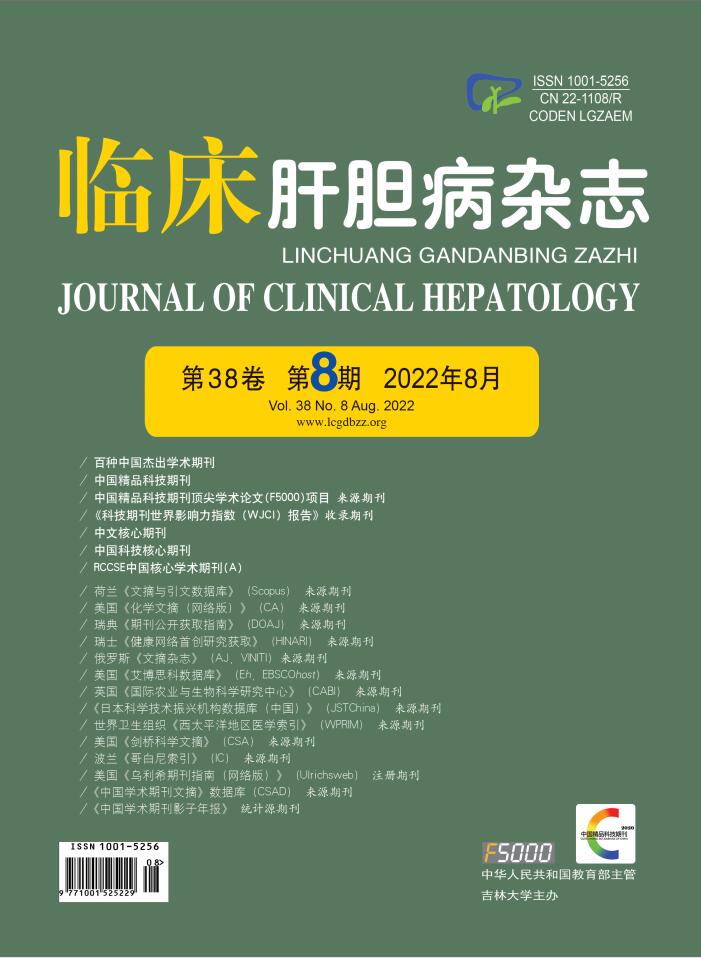| [1] |
LAMMERT F, GURUSAMY K, KO CW, et al. Gallstones[J]. Nat Rev Dis Primers, 2016, 2: 16024. DOI: 10.1038/nrdp.2016.24. |
| [2] |
ZHU Q, SUN X, JI X, et al. The association between gallstones and metabolic syndrome in urban Han Chinese: a longitudinal cohort study[J]. Sci Rep, 2016, 6: 29937. DOI: 10.1038/srep29937. |
| [3] |
|
| [4] |
National Cholesterol Education Program (NCEP) Expert Panel on Detection, Evaluation, and Treatment of High Blood Cholesterol in Adults (Adult Treatment Panel Ⅲ). Third report of the National Cholesterol Education Program (NCEP) expert panel on detection, evaluation, and treatment of high blood cholesterol in adults (Adult Treatment Panel Ⅲ) final report[J]. Circulation, 2002, 106(25): 3143-3421. DOI: 10.1161/circ.106.25.3143 |
| [5] |
YANG JL, HUANG JJ, CHENG N, et al. Sex-specific and dose-response relationship between the incidence of gallstones and components of the metabolic syndrome in Jinchang Cohort: a prospective study[J]. Biomed Environ Sci, 2020, 33(8): 633-638. DOI: 10.3967/bes2020.084. |
| [6] |
TSAI CH, WU JS, CHANG YF, et al. The number of metabolic abnormalities associated with the risk of gallstones in a non-diabetic population[J]. PLoS One, 2014, 9(3): e90310. DOI: 10.1371/journal.pone.0090310. |
| [7] |
YANG LZ, PENG XY, ZHANG HW, et al. A comparative analysis of the blood lipid levels and body mass index in the female patients with simple cholelithiasis of Uyghur and Han nationality[J]. Chin J Mod Med, 2021, 31(16): 59-62. DOI: 10.3969/j.issn.1005-8982.2021.16.011. |
| [8] |
|
| [9] |
PANG HR, XU SZ, DING YS, et al. Epidemiological characteristics of metabolic syndrome among the Kazak, Uygur and Han people aged 60 years and above in Xinjiang[J]. J Pract Med, 2014, 30(17): 2843-2846. DOI: 10.3969/j.issn.1006-5725.2014.17.053. |
| [10] |
The Cooperation Group of the Chinese Medical Association Diabetes Branch studying on the Metabolic Syndrome. Suggestion for the metabolic syndrome by the Chinese Medical Association Diabetes Branch[J]. Clin J DIabetes, 2004, 12(3): 5-10. DOI: 10.3321/j.issn:1006-6187.2004.03.002 |
| [11] |
ANDERSSON T, ALFREDSSON L, KÄLLBERG H, et al. Calculating measures of biological interaction[J]. Eur J Epidemiol, 2005, 20(7): 575-579. DOI: 10.1007/s10654-005-7835-x |
| [12] |
MÉNDEZ-SÁNCHEZ N, CHAVEZ-TAPIA NC, MOTOLA-KUBA D, et al. Metabolic syndrome as a risk factor for gallstone disease[J]. World J Gastroenterol, 2005, 11(11): 1653-1657. DOI: 10.3748/wjg.v11.i11.1653. |
| [13] |
NERVI F, MIQUEL JF, ALVAREZ M, et al. Gallbladder disease is associated with insulin resistance in a high risk Hispanic population[J]. J Hepatol, 2006, 45(2): 299-305. DOI: 10.1016/j.jhep.2006.01.026. |
| [14] |
LITTLEFIELD A, LENAHAN C. Cholelithiasis: presentation and management[J]. J Midwifery Womens Health, 2019, 64(3): 289-297. DOI: 10.1111/jmwh.12959. |
| [15] |
LIOUDAKI E, GANOTAKIS ES, MIKHAILIDIS DP. Lipid lowering drugs and gallstones: a therapeutic option?[J]. Curr Pharm Des, 2011, 17(33): 3622-3631. DOI: 10.2174/138161211798220909. |
| [16] |
SHEBL FM, ANDREOTTI G, MEYER TE, et al. Metabolic syndrome and insulin resistance in relation to biliary tract cancer and stone risks: a population-based study in Shanghai, China[J]. Br J Cancer, 2011, 105(9): 1424-1429. DOI: 10.1038/bjc.2011.363. |
| [17] |
NAKEEB A, COMUZZIE AG, Al-Azzawi H, et al. Insulin resistance causes human gallbladder dysmotility[J]. J Gastrointest Surg, 2006, 10(7): 940-948, 948-949. DOI: 10.1016/j.gassur.2006.04.005. |
| [18] |
LIU CM, HSU CT, LI CY, et al. A population-based cohort study of symptomatic gallstone disease in diabetic patients[J]. World J Gastroenterol, 2012, 18(14): 1652-1659. DOI: 10.3748/wjg.v18.i14.1652. |
| [19] |
AUNE D, VATTEN LJ. Diabetes mellitus and the risk of gallbladder disease: A systematic review and meta-analysis of prospective studies[J]. J Diabetes Complications, 2016, 30(2): 368-373. DOI: 10.1016/j.jdiacomp.2015.11.012. |
| [20] |
ALI AK, ADETUNJI OR. Incidence and prevalence of bile duct and gallbladder disease in patients with diabetes in the U.S. [J]. Diabetes, 2018, 67(Suppl 1): 1559-P. DOI: org/10.2337/db18-1559-P. |
| [21] |
BIDDINGER SB, HAAS JT, YU BB, et al. Hepatic insulin resistance directly promotes formation of cholesterol gallstones[J]. Nat Med, 2008, 14(7): 778-782. DOI: 10.1038/nm1785. |
| [22] |
de BOER SY, MASCLEE AA, LAMERS CB. Effect of hyperglycemia on gastrointestinal and gallbladder motility[J]. Scand J Gastroenterol Suppl, 1992, 194: 13-18. DOI: 10.3109/00365529209096020. |
| [23] |
|
| [24] |
LIEW PL, WANG W, LEE YC, et al. Gallbladder disease among obese patients in Taiwan[J]. Obes Surg, 2007, 17(3): 383-390. DOI: 10.1007/s11695-007-9068-4. |
| [25] |
LIN IC, YANG YW, WU MF, et al. The association of metabolic syndrome and its factors with gallstone disease[J]. BMC Fam Pract, 2014, 15: 138. DOI: 10.1186/1471-2296-15-138. |
| [26] |
CHEN LY, QIAO QH, ZHANG SC, et al. Metabolic syndrome and gallstone disease[J]. World J Gastroenterol, 2012, 18(31): 4215-4220. DOI: 10.3748/wjg.v18.i31.4215. |
| [27] |
WANG J, SHEN S, WANG B, et al. Serum lipid levels are the risk factors of gallbladder stones: a population-based study in China[J]. Lipids Health Dis, 2020, 19(1): 50. DOI: 10.1186/s12944-019-1184-3. |
| [28] |
KIM SS, LEE JG, KIM DW, et al. Insulin resistance as a risk factor for gallbladder stone formation in Korean postmenopausal women[J]. Korean J Intern Med, 2011, 26(3): 285-293. DOI: 10.3904/kjim.2011.26.3.285. |
| [29] |
AMIGO L, ZANLUNGO S, MENDOZA H, et al. Risk factors and pathogenesis of cholesterol gallstones: state of the art[J]. Eur Rev Med Pharmacol Sci, 1999, 3(6): 241-246.
|
| [30] |
|
| [31] |
GUO S. Insulin signaling, resistance, and the metabolic syndrome: insights from mouse models into disease mechanisms[J]. J Endocrinol, 2014, 220(2): T1-T23. DOI: 10.1530/JOE-13-0327. |
| [32] |
KARHAPÄÄ P, MALKKI M, LAAKSO M. Isolated low HDL cholesterol. An insulin-resistant state[J]. Diabetes, 1994, 43(3): 411-417. DOI: 10.2337/diab.43.3.411. |
| [33] |
JANZON L, ASPELIN P, ERIKSSON S, et al. Ultrasonographic screening for gallstonedisease in middle-aged women. Detection rate, symptoms, and biochemical features[J]. Scand J Gastroenterol, 1985, 20(6): 706-710.
|







 DownLoad:
DownLoad: